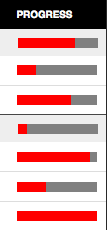IE 10 has recently graduated from beta and is now the current official release. It started out Windows 8 only, but now is available on 7 as well as a preview release. Hopefully that will allow it to grab more IE users quickly. IE, which has long been the bane of web developers, has been getting better and better with each release. IE 6 has always been a pain to develop for, having many bugs/quirks in rendering pages. In all but fairly simple sites, it always took me a fair amount of time to fix after getting things looking right in other browsers. Luckily, the market share is low enough that at work we don’t even worry about it anymore. IE 7 was better. Using a subset of HTML4/CSS2 level development, I usually have had to do only minor tweaks unless the sites were fairly complex. Luckily, It’s share is almost to the cutoff point where we stop developing for it as well. With IE 8, I’ve been able to do most HTML4/CSS2 level stuff without worries. display: inline-block;, :before, :after, onhashchange, etc. It still remains a limiter in using some selectors and in making use of HTML5/CSS3 level techniques, though using an HTML5 shiv and CSS3 PIE or allowing for progressive enhancement to skip over some features in it works rather well. IE 9 has brought some HTML5/CSS3 stuff to the table, like selectors, HTML5 semantic elements, SVG, though it’s missing some important ones, like CSS3 columns and HTML5 form stuff. Since I develop to support IE 8 usually without browser specific tweaks, IE 9 basically works automatically, and has some style enhancements over 8.
And now there’s IE 10. IE 10 has added a lot more and is finally coming close to other browsers in implementing the not-yet-fully-standardized standards. It’s still missing some good ones, but the list of things that have to be skipped, worked around, etc, for IE’s current version has shrunk a good bit. It even implements some features that others haven’t yet.
The big one is the CSS3 grid layout module, which is the one I’m most excited about for the future. This module is pretty close to allowing for a real decoupling of markup from style that CSS has promised finally for page layout.
Continue reading post "IE 10 and CSS Grid Layout"